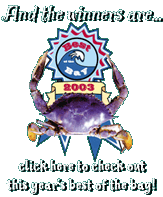Chesapeake Outdoors ~ by C. D. Dollar  The Big Unknown
The Big Unknown
The little green heron nervously hopscotched from stump to stump, irritated by the clumsy shadow that wasn’t even his own. Shards of old trees shot up through the water, exposed by the falling tide and worn to an inky black, smoothly sculpted from years of wind and sea. The sprightly bird glanced over its shoulder, checking on the position of its pursuer. When it felt the gap had closed too much, it glided to another outcropping.
The shadow paddled on, dipping the blade quietly into the water. Pausing, the curious paddler wondered where that tiny bird rode out the blistering winds that tore off huge chunks of shoreline and felled massive trees. It seemed unaffected by the Chesapeake’s first hurricane in four years.
Like a banshee, Isabel charged up the Chesapeake with reckless power, ravaging marinas, homes and hotels while tossing boats around like tinker toys. From Virginia Beach to Baltimore — and in many low-lying towns in between — the massive storm surge forced residents of coastal communities to evacuate. North Carolina, Virginia, Maryland and Delaware were declared federal disaster areas. Friends in Virginia said the number of downed trees is staggering.
The energy of a hurricane can excite and frighten, often at once. Some of us are drawn to its power, even while it rages. In the aftermath, I count myself among the fortunate, spared from the full wrath of this powerful storm.
In Isabel’s wake, as power gets restored and cleanup carries on, many people wonder how the Bay weathered the storm. By Tuesday, experts said the amount of water flowing into the Bay was four times the normal amount. The U.S. Geological Survey estimates 42,000 tons of sediment stuff washed into Chesapeake waterways at the storm’s peak, making the Bay’s fragile underwater grass beds and remnant oysters reefs particularly vulnerable.
In 1972, massive sediment loading from Tropical Storm Agnes wiped out nearly two-thirds of the Chesapeake’s underwater grasses, which some say have never fully recovered from that massive sediment dump. Isabel didn’t unload nearly as much rainfall as Agnes, but there were considerably more acres of grasses two decades ago.
The tons of raw sewage spilled from plants rendered inoperable from the storm convinced state health officials in both Virginia and Maryland to prohibit harvesting on shellfish beds. Contaminated water could affect the October 1 start date of Maryland’s commercial oyster season, state officials said.
Add a torrent of nutrients from farms and lawns, chemicals, oil, and gasoline and you have a hellacious mess. The Chesapeake is in such poor health that it can ill afford such a shock. How fast and how strong our Bay and its rivers can rebound, or whether it ever can, from Isabel’s jolt is the Big Unknown.
Fish Are Biting
Recreational fishing is inconsequential, of course, given the circumstances, but as of Tuesday afternoon, most charter fishing remained shut down, costing captains money during the best fishing of the year.

 The Big Unknown
The Big Unknown